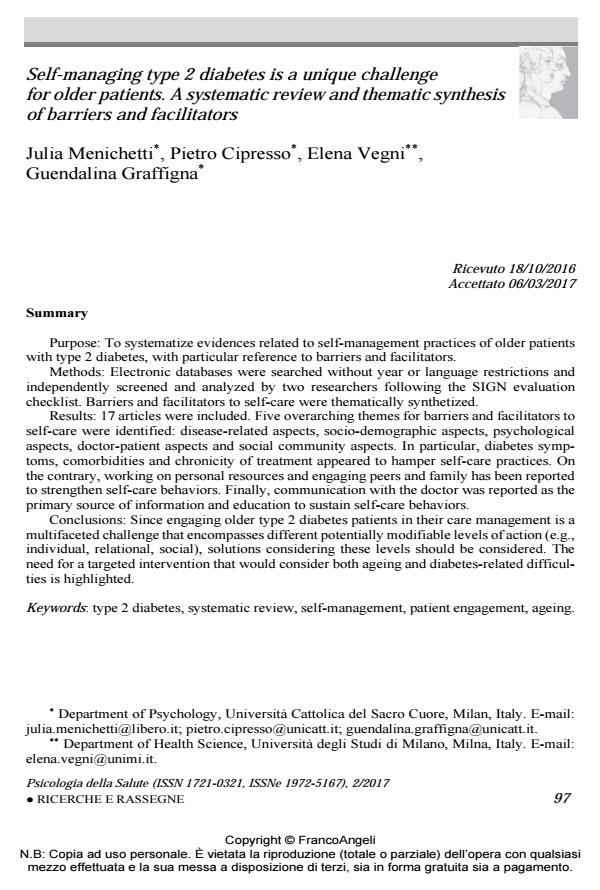Self-managing type 2 diabetes is a unique challenge for older patients. A systematic review and thematic synthesis of barriers and facilitators
Titolo Rivista PSICOLOGIA DELLA SALUTE
Autori/Curatori Julia Menichetti, Pietro Cipresso, Elena Vegni, Guendalina Graffigna
Anno di pubblicazione 2017 Fascicolo 2017/2
Lingua Inglese Numero pagine 24 P. 97-120 Dimensione file 467 KB
DOI 10.3280/PDS2017-002005
Il DOI è il codice a barre della proprietà intellettuale: per saperne di più
clicca qui
Qui sotto puoi vedere in anteprima la prima pagina di questo articolo.
Se questo articolo ti interessa, lo puoi acquistare (e scaricare in formato pdf) seguendo le facili indicazioni per acquistare il download credit. Acquista Download Credits per scaricare questo Articolo in formato PDF

FrancoAngeli è membro della Publishers International Linking Association, Inc (PILA)associazione indipendente e non profit per facilitare (attraverso i servizi tecnologici implementati da CrossRef.org) l’accesso degli studiosi ai contenuti digitali nelle pubblicazioni professionali e scientifiche
Purpose: To systematize evidences related to self-management practices of older patients with type 2 diabetes, with particular reference to barriers and facilitators. Methods: Electronic databases were searched without year or language restrictions and independently screened and analyzed by two researchers following the SIGN evaluation checklist. Barriers and facilitators to self-care were thematically synthetized. Results: 17 articles were included. Five overarching themes for barriers and facilitators to self-care were identified: disease-related aspects, socio-demographic aspects, psychological aspects, doctor-patient aspects and social community aspects. In particular, diabetes symptoms, comorbidities and chronicity of treatment appeared to hamper self-care practices. On the contrary, working on personal resources and engaging peers and family has been re-ported to strengthen self-care behaviors. Finally, communication with the doctor was reported as the primary source of information and education to sustain self-care behaviors. Conclusions: Since engaging older type 2 diabetes patients in their care management is a multifaceted challenge that encompasses different potentially modifiable levels of action (e.g., individual, relational, social), solutions considering these levels should be considered. The need for a targeted intervention that would consider both ageing and diabetes-related difficulties is highlighted.
Obiettivo del presente contributo è sistematizzare le evidenze scientifiche inerenti le pratiche di gestione autonoma del diabete di tipo 2 in pazienti anziani, con una particolare at-tenzione ai fattori che possono ostacolare e facilitare un simile processo. A tal fine, è stata condotta un’analisi sistematica della letteratura su articoli estratti dai principali database scientifici, senza limiti di anno o di lingua di pubblicazione. Gli articoli estratti sono stata analizzati indipendentemente da due ricercatori seguendo una griglia costruita ad hoc e seguendo la SIGN checklist per la valutazione metodologica degli articoli. Le barriere e i facilitatori per la gestione autonoma della malattia sono stati sintetizzati tematicamente. 17 articoli sono stati inclusi nelle analisi. Cinque principali temi inerenti le barriere ed i facilitatori delle pratiche di gestione autonoma del diabete di tipo 2 nei pazienti anziani sono stati identificati: aspetti connessi alla malattia, aspetti socio-demografici, aspetti psicologici, aspetti legati alla relazione medico-paziente e aspetti legati al contesto sociale. In particolare, la sintomatologia, le comorbidità e la cronicità dei trattamenti appiano ostacolare principalmente le pratiche di gestione autonoma della malattia. Dall’altra parte, lavorare sulle risorse personali e coinvolgere la rete di pari e familiari rappresentano utili strategie per supportare le pratiche di gestione autonoma della malattia. Infine, la comunicazione con i professionisti sanitari risulta essere la principale fonte di informazione ed educazione per favorire comportamenti di self-care. Poiché coinvolgere i pazienti anziani affetti da diabete di tipo 2 nella gestione della loro malattia si configura come una sfida unica e multisfaccettata che coinvolge diversi livelli di azione potenzialmente modificabili (individuale, relazionale, sociale), si auspica l’individuazione di azioni capaci di considerare questi diversi livelli di azione. Inoltre, emerge il bisogno di un intervento specificamente dedicato ai pazienti anziani, che consideri sia le difficoltà connesse all’invecchiamento sia quelle connesse al diabete di tipo 2.
Parole chiave:Diabete di tipo 2, analisi sistematica della letteratura, gestione autonoma della malattia, coinvolgimento attivo, invecchiamento.
Julia Menichetti, Pietro Cipresso, Elena Vegni, Guendalina Graffigna, Self-managing type 2 diabetes is a unique challenge for older patients. A systematic review and thematic synthesis of barriers and facilitators in "PSICOLOGIA DELLA SALUTE" 2/2017, pp 97-120, DOI: 10.3280/PDS2017-002005